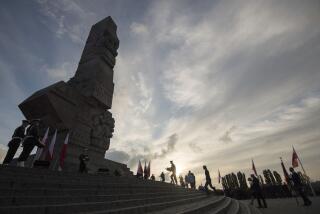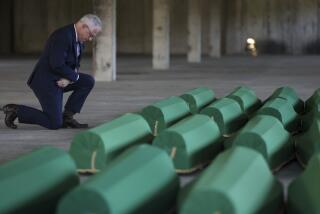Victims of Village Massacre Laid to Rest
VELIKA KRUSA, Yugoslavia — This southern Kosovo village carried out the largest mass funeral so far for victims of Serbian atrocities in Kosovo after British forensic investigators Sunday finished their examination of a burned house containing the remains of more than 40 men and teenage boys.
The killings at Velika Krusa, a village known in Albanian as Krusha e Madhe, were among the first war crimes to come to the world’s attention at the start of the NATO bombing campaign when, in early April, an amateur cameraman smuggled out to Albania a videotape showing a large number of shot and burned bodies.
The slayings are one of the specific crimes cited by the International Criminal Tribunal for the Former Yugoslavia in its recent indictment of Yugoslav President Slobodan Milosevic and four associates.
The village of burned-out brick houses spreads on both sides of a main highway that is now filled with North Atlantic Treaty Organization convoys. But at the end of March, survivors say, it was Yugoslav forces who cruised up and down the road setting afire ethnic Albanian villages, forcing inhabitants to flee to Albania and, in many cases, summarily executing men of military age.
The killings here are believed to have occurred shortly after Serbian forces surrounded the village March 25.
Several hundred male villagers are still missing, and residents say they suspect that the men may have been buried by the Serbs in other, as yet undiscovered, mass graves.
The British forensic team, along with two representatives of the international war crimes tribunal, spent one week sifting through the charred remains before the funeral was allowed to take place.
A backhoe carved two long trenches, about 3 feet deep and 6 feet wide, in the village graveyard. There men unloaded the blue and black body bags from a flatbed truck, laid them in the earth side by side, sprinkled wildflowers over them and pushed dirt onto them before carefully tamping down the new grave.
An honor guard from the rebel Kosovo Liberation Army fired a final six-gun salute. The mourners, about 400 village men and boys and the international criminal investigators, dispersed just before sunset.
“We are happy for the burial, but we still don’t know who they are. There is no positive identification,” said Avni Duraku, one of the village residents leading the funeral.
Dr. Sue Black, a Scottish forensic anthropologist working with the British team, said the site that was examined contained the remains of between 40 and 50 individuals in two rooms and the yard of a burned house. One room contained about 25 individuals and the other about 15.
“They herded people into there, shot them and set fire to the premises,” she said of the remains excavated from beneath the collapsed roof of the building. The victims appeared to range from about 16 years of age to their 50s.
The remains had been badly burned, were decomposed and had been scattered by animals, making identification impossible, she said.
Aside from the noise of the backhoe and the sound of fresh earth being pounded down by shovels and hoes, the burial took place in silence.
“I feel such pain I cannot express,” said Abdurrahman Doroku, one of the mourners.
More to Read
Sign up for Essential California
The most important California stories and recommendations in your inbox every morning.
You may occasionally receive promotional content from the Los Angeles Times.










